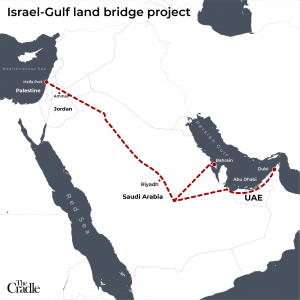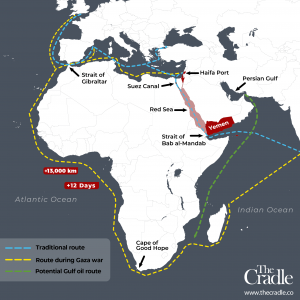Yemen’s attacks on Israel’s vital shipping routes has compelled the occupation state to seek an alternative land corridor via Saudi Arabia, the UAE and Jordan, whose legitimacy is being corroded on the Arab street, while Sanaa’s is on the rise.

In early December, Israeli media broke the news of an agreement to establish a land bridge between the port of Dubai and the occupied port of Haifa. The reports claim this strategic accord aims to circumvent the growing Yemeni threat to close vital sea lanes to vessels associated with and/or destined for Israeli ports.
Just a fortnight later, the Israeli Walla website revealed that the first shipment, originating from Dubai and traversing the newly established land corridor encompassing the UAE, Saudi Arabia, Jordan, and Israel, had arrived at Israeli ports.
In safeguarding and supporting Israel, these three Arab states have reaffirmed their essential role in protecting and defending the occupation state, enabling it to continue its atrocities against the Palestinians.

Yemen’s Red Sea blockade on Israel
On 15 November, Abdul Malik al-Houthi, leader of Yemen’s Ansarallah movement, declared a blockade on Israeli ships passing through the Red Sea and the Bab al-Mandab Strait. This proclamation marked the initiation of a naval conflict with Israel in solidarity with Gaza, heralding a new phase of confrontation that Israel had anticipated for several years.
Since 2018, Israeli Prime Minister Benjamin Netanyahu, apprehensive of Ansarallah’s presence along the Red Sea coast, asserted Tel Aviv’s commitment to any international effort preventing the closure of shipping routes in the region.
A 2021 report published by Israel’s National Security Research Center states that “the possibility of the Houthis attacking ships in shipping lanes along the Bab al-Mandab Strait, the Red Sea, or the Gulf of Aden poses a tangible threat to Israeli national security.”
The same report states that Yemenis may in the future intercept Israeli ships passing through the Bab al-Mandab Strait in order to pressure Israel to change certain policies.
Four days after Houthi’s promise to target Israeli vessels, Yemeni forces seized a transport ship with ties to Israeli tycoon Avraham Ongar, one of the country’s wealthiest magnates. Ansarallah-aligned military spokesman Yahya Saree justified the seizure as a response to “heinous acts against our Palestinian brothers in Gaza and the West Bank,” adding:
“If the international community is concerned about regional security and stability, rather than expanding the conflict, it should put an end to Israel’s aggression against Gaza.”
On 12 December, Yemen launched a missile strike on a Norwegian oil ship destined for Israel’s Ashdod Port in January. Saree explained that the targeting followed the crew’s refusal to heed warnings and announced the continuation of ship blockades until Israel permitted essential aid into Gaza.
The Pentagon confirmed the interception of Yemeni drones targeting Israeli ships, and called for an international solution to an “international problem.”
Bab al-Mandeb’s strategic significance
The Bab al-Mandab Strait serves as a crucial trade route connecting the Mediterranean and the Indian Ocean, with an annual value of approximately $700 billion. This vital waterway sees 4 million barrels of oil passing through daily, representing 10 percent of global maritime trade and supporting the flow of 25,000 ships.
Recent figures for the first half of 2023 show that the Bab al-Mandab handles quantities of crude oil, condensate, and petroleum products equivalent to those passing through the Suez Canal. Similarly, the volume of liquefied natural gas (LNG) passing through the strait rivals that of the Suez, which is approximately 4 billion cubic feet of gas per day.
Freightos, an Israeli shipping company, reported a notable 9-14 percent increase in shipping costs from China to the Israeli port of Ashdod in the last two weeks of October.
Judah Levin, head of research at Freightos, told the Israeli newspaper Globes that the outbreak of war “is already affecting all goods reaching Israel from China, the prices of which have started to rise in the past few weeks.”
The significance of this rise comes from the fact that China is currently Israel’s largest trading partner by sea, with sea-borne cargo from China amounting to 20 percent of Israel’s total maritime imports.
‘Axis of Normalization’ comes to the rescue
Due to Sanaa’s bold move, the perceived threat to Israeli shipping in the Bab al-Mandab has prompted the occupation state to explore alternative routes for importing and exporting goods.
Unsurprisingly, the UAE, the Arab county that spearheaded the Abraham Accords’ normalization thrust with Israel, has stepped in to assist in overcoming the Yemeni obstacle.

According to reports from Israeli media, the collaborative effort between the UAE and Israel to set up a land bridge connecting the port of Dubai to Haifa, pass through Saudi Arabia and Jordan. However, Amman has since denied these reports, claiming them to be “absolutely false.”
By mid-December, goods began flowing through this corridor, with Walla reporting the arrival of ten trucks from Dubai to the port of Haifa in recent days. There is no doubt that this corridor offers a strategic solution, allowing ships bound for Israel to bypass the Yemeni threat.
However, its successful implementation only goes to show the willingness of Saudi Arabia and Jordan to be integral parts of this strategic initiative – a move that could further delegitimize their rulers with the overwhelmingly pro-Palestine Arab street.
Notably, such a land corridor only requires agreements between the involved parties, while leveraging existing international routes.
The land bridge not only offers an alternative for Chinese ships which transport one-fifth of Israeli sea-borne imports, but also reduces the lengthy journey around the south and west of Africa to reach the Strait of Gibraltar from 31 days to 19 days.
Counting the costs
The land route connecting Dubai and Haifa spans 2550 km, with trucks requiring approximately four days to traverse it – a shorter duration compared to ships navigating the Red Sea and the Suez Canal.
While the transportation cost per kilometer is slightly higher than the Red Sea route, it is significantly lower than the current cost of shipping through the Strait of Gibraltar.
Despite the cargo capacity limitations of the land corridor (around 350 trucks per day) compared to shipping vessels, it offers expedited transit from Dubai to Europe, saving around 10 transportation days over the Suez Canal route.
But while the corridor might be adequate for meeting Israel’s immediate needs amid Yemeni threats, it falls short of providing a complete alternative for sea routes to Europe. This development suggests that Israel could potentially withdraw from maritime shipping, posing a challenge to Egypt and the Suez Canal.
Further down the line, it is possible that the land corridor may also attract a number of Asian and European states. Egypt, it must be emphasized, begins to lose out as soon as the Dubai-Haifa land route is adopted, as the vessels that circumvent the Red Sea also naturally bypass the Suez route.
However, the greater threat to Egypt’s economic interests lies in the prospect of future railway links connecting Dubai with the occupation state, significantly enhancing shipping capacity and reducing costs and transit times.
Yemen stands against Israel
As the land corridor gains traction, reports suggest that risk management firm Ambrey has advisedship owners to assess vessels with Israeli links due to potential mobility challenges. Nevertheless, the commencement of the land corridor stands as a boon for the occupation state and its businessmen by eliminating the need to utilize the Red Sea route.
It should be noted that the adoption of the land corridor opens avenues for Israel to connect with other international corridors through the UAE, Saudi Arabia, and Jordan. The North-South corridorconnecting Russia, Iran and India, was linked to Saudi Arabia this year, which can funnel those goods on to Israel now.
That too applies to the China-Pakistan Economic Corridor (CPEC), a cornerstone of Beijing’s Belt and Road Initiative (BRI), which transports goods to and from China through the Pakistani port of Gwadar.
From Gwadar, goods travel to UAE ports and then, potentially, through the land corridor to Israel. In this way, the three Arab states, Saudi Arabia, the UAE, and Jordan, can link Israel to other key international corridors – unless Iran and Pakistan decide to throw a wrench in those works.
What all this makes clear, however, is that Yemen’s entry into the frontline battle against Israel and in support of Palestine has reverberated globally. The impoverished nation, despite facing years of conflict, now poses a significant and growing threat to Israel’s national security and supply lines through its actions in the Bab al-Mandab.
By aligning its maritime attacks to the cessation of Tel Aviv’s horrifying siege of Gaza, Ansarallah has forced the world to pay greater attention to the magnitude of Israel’s unprecedented military campaign against Palestinian civilians in Gaza.
Conversely, the collaborative moves by the UAE, Saudi Arabia, and Jordan to open up a land bridge to Haifa underscores their preference to pander to Israel over buttressing Arab and Muslim solidarity.
By Mohamad Hasan Sweidan
Published by The Cradel
Republished by The 21st Century
The views expressed in this article are solely those of the author and do not necessarily reflect the opinions of 21cir.com.
